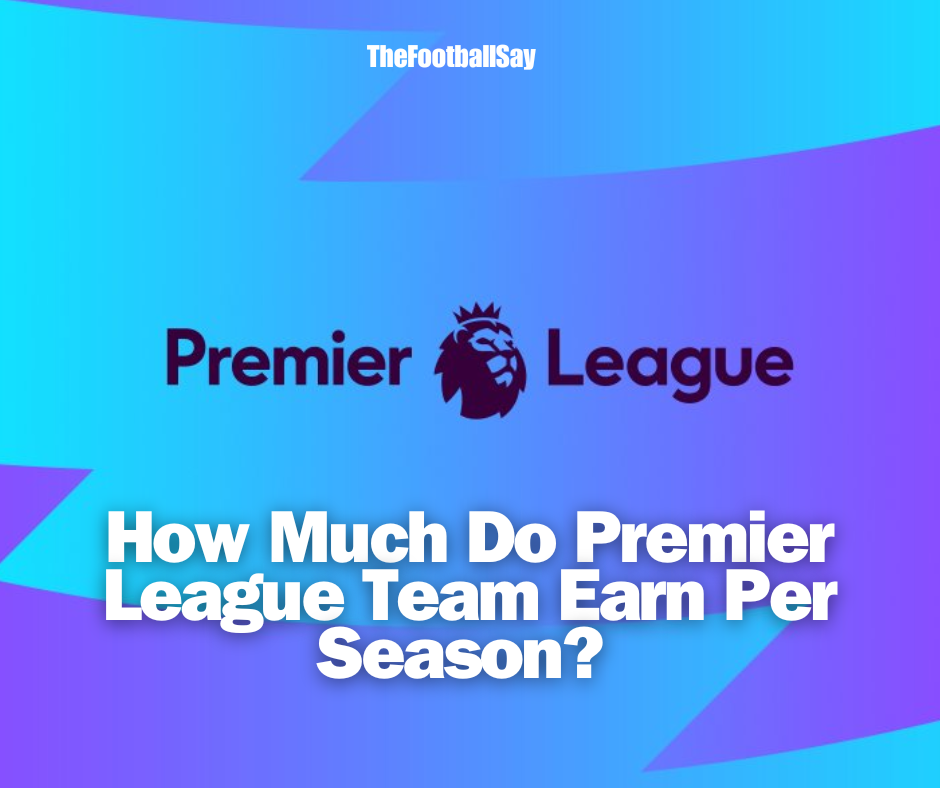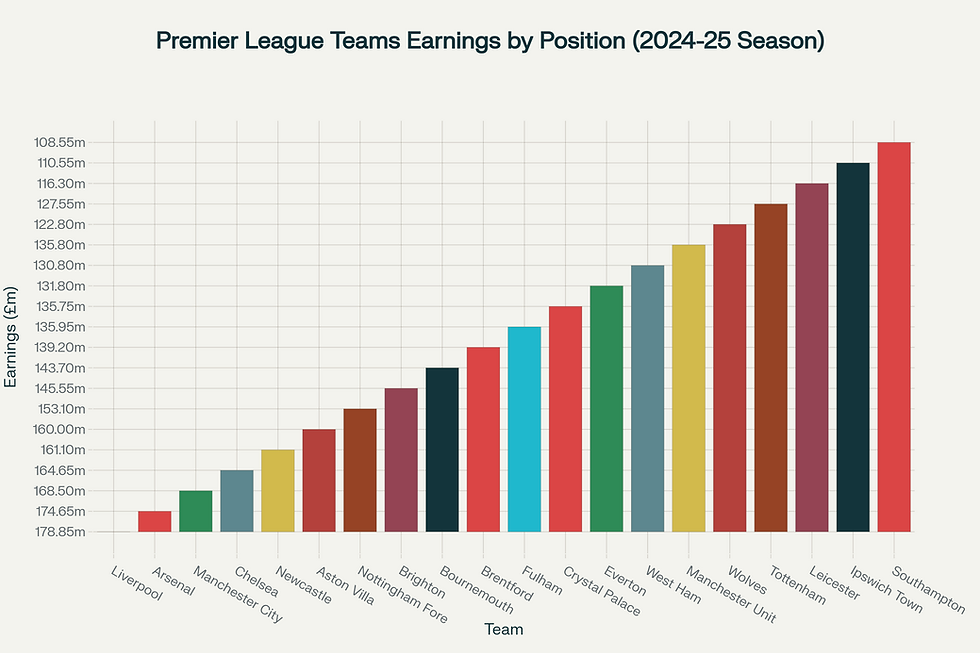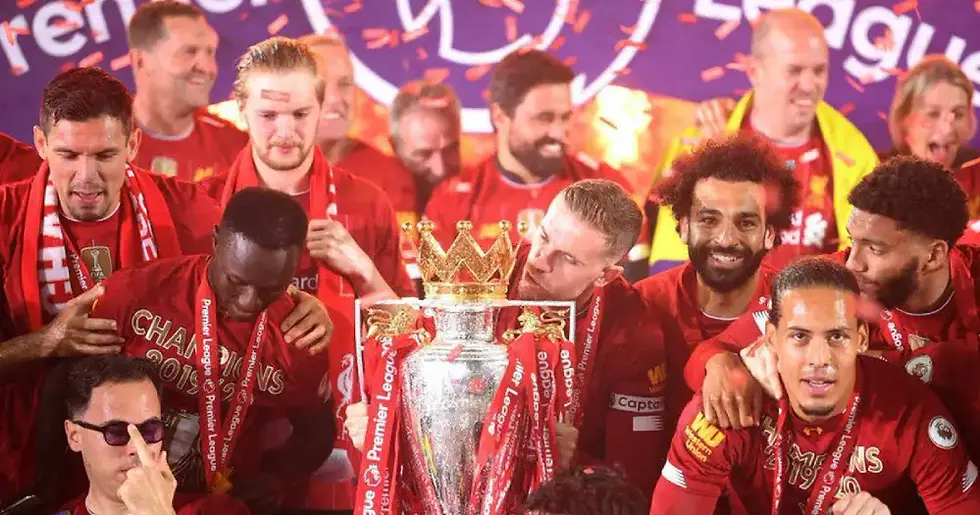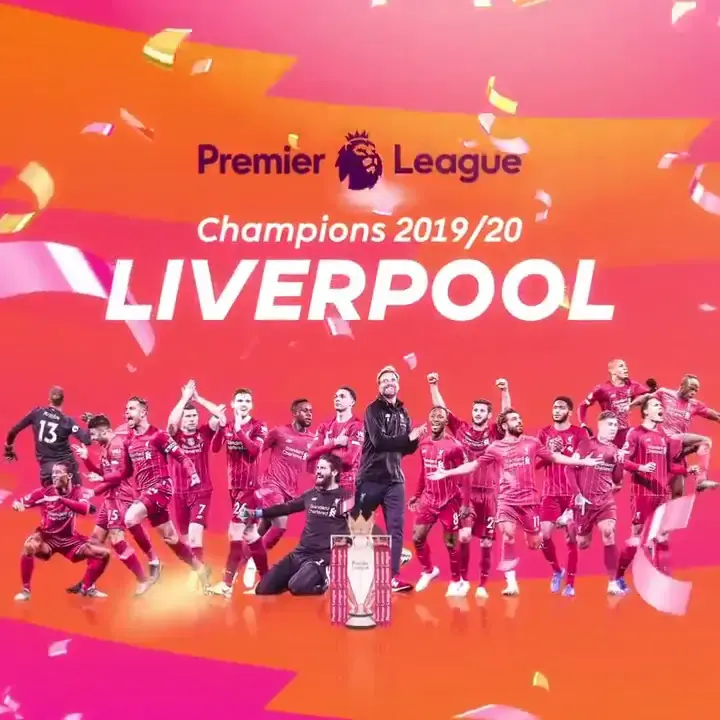Premier League Prize Money: How Much Do Teams Earn per Position?
- Bikram Rana
- Aug 2
- 4 min read
The Premier League is crazy when it comes to money. More than half of the world knows about the league.
It has seen a serious rise in popularity in recent times, with viewers from countries like India, the Philippines, Malaysia, Bangladesh, Thailand, etc.
The growth of English football has seen the biggest boom in the last decade.
Hence, the English Premier League is not only the most watched domestic football competition on the planet—it’s also the most lucrative.
You can just imagine the mouth-watering money it generates single season, the season ticket sales dry up as soon as it gets announced, a 50000+ capacity stadium gets packed in every game, fan events, matchday revenue, TV rights, sponsors, etc, everybody makes a share that is being collected by the Premier League.

Based on that, among each season, the 20 clubs in the league receive substantial payments based on their final standing, their broadcast exposure, and central revenue sharing.
We will help you figure out how much each Premier League team earns, position by position, and explain why these sums matter more than ever for the business of football.
Understand the components of Premier League Payouts
The prize money distributed among clubs is not a simple one-size-fits-all figure. Each club's payout comprises several components:
Merit Payment: Based on league position, with each higher spot earning incrementally more.
Broadcast (Facility) Fees: Tied to the number of matches broadcast live.
Equal Share Payments: Distributed evenly from domestic and international TV rights.
Central Commercial Revenue: Brand partnerships and commercial deals are shared among clubs.
In the 2024-25 season, every finishing position in the league was worth about £3.1 million more than the next lower spot. The difference between top and bottom is genuinely jaw-dropping.
Detailed Prize Money Table by Position (2024-25)
Here’s a unique and clear breakdown of how much each place was worth to the clubs in 2024-25. This includes core “merit payments” but keep in mind that TV appearances and other [central revenue] sources cause totals to vary by millions
.
Position | Team* | Merit Payment (£m) | Approximate Total Earnings (£m, all sources) |
1st | Liverpool | 56.4 | 176.2–181.5 |
2nd | Arsenal | 53.5 | 171.5–177.8 |
3rd | Manchester City | 50.7 | 165.5–171.5 |
4th | Chelsea | 47.9 | 163.7–165.6 |
5th | Newcastle | 45.1 | 160.2–162.0 |
6th | Aston Villa | 42.2 | 159.3–160.7 |
7th | Nottingham Forest | 39.4 | 152.5–153.7 |
8th | Brighton | 36.7 | 145.1–146.0 |
9th | Bournemouth | 33.8 | 143.4–144.0 |
10th | Brentford | 31.0 | 138.9–139.5 |
11th | Fulham | 28.2 | 135.5–136.4 |
12th | Crystal Palace | 25.4 | 136.1–135.4 |
13th | Everton | 22.5 | 131.8 |
14th | West Ham | 19.7 | 130.9–130.7 |
15th | Manchester United | 16.9 | 136.2–135.4 |
16th | Wolves | 14.0 | 123.1–122.5 |
17th | Tottenham | 11.3 | 127.8–127.3 |
18th | Leicester | 8.5 | 116.9–115.7 |
19th | Ipswich Town | 5.7 | 111.1–110.0 |
20th | Southampton | 2.8 | 109.2–107.9 |
Teams listed as per the final 2024-25 standings for illustration.

How Is the Prize Money Divided?

Every club receives a huge “equal share”—guaranteed at around £95 million per team, before performance and broadcast bonuses.
Facility Fees (for televised matches) add up to as much as £26 million for teams like Liverpool or Arsenal, based on TV selections.
Merit Payments are strictly regulated: finishing 1st, a team earns the maximum, with the payout shrinking by about £3.1 million per rank down to £3.1m for 20th.
Central revenue, such as sponsorships, adds a baseline extra amount, further swelling club coffers.
What Makes Premier League Distribution Unique?
The Premier League shares revenue more evenly than almost any other European league, creating greater competition and financial health across the table.
Even relegated teams (“parachute payments”) walk away with over £100m, underlining the league’s extraordinary wealth.
The gap between 1st and 20th, however, can be upwards of £60–75 million, which is a powerful incentive for every club to fight for every position to the last day.
If you talk about sponsorship, the Premier League is where brand wants to put their money because of the visibility it gets, it is not just for the league billboards but also clubs, for example, the iconic collaboration of Vodafone and Arsenal saw a meteoric rise in the brand’s global visibility.

Or the AIG collaboration with Manchester United. A very solid reason why brands would pay extra to become a sponsor for Premier League teams.
Premier League is also followed by the of ages all kind, you have the old viewers, the young and the middle-aged, a perfect target audience setting for all the brands involved.
Why Does This Money Matter?
Premier League earnings affect everything: from buying star players to funding youth academies and community projects. For bottom-half clubs, even moving up a single spot represents extra millions—money vital for transfers, paying debts, or reinvesting in facilities.
For the biggest clubs, the vast sums ensure they remain competitive on the European stage, but also raise the stakes for any failure.

Premier League football is as much about finance as it is about flair. The league’s unique revenue structure incentivises competition from top to bottom, and every position—down to the very last—is worth a fortune. Whether you finish champions or rock bottom, playing in the Premier League is one of the most lucrative prospects in world sport.
If you want to understand the pressure on clubs to avoid relegation or chase a European place, just look at the numbers—for some, a last-minute goal is worth over £3 million.
*All figures are approximations for 2024-25 and can vary slightly by official club reporting, currency shifts, and TV contract terms.



Comments